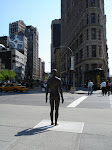Today I was back at the Flatiron Building, where I always seem to end up, across the street at Eisenberg's Sandwich Shop. There I met with the great-grandson of Billy Dell, one of the foremen at the Flatiron construction site in 1902. When Thomas Farawell came across his great-grandfather's name while reading my book, he contacted me. Whenever my father and I walked past the Flatiron, Thomas told me today, he'd say, "Your great-grandfather built this!" Billy "Bull" Dell came to New York from Chicago with his pal Sam Parks, the violent and corrupt leader of the Ironworkers Union, whom George Fuller paid handsomely to keep his rank-and-file from striking at Fuller Company construction sites.
Thomas brought along a photo to show me: his great-grandfather seated with eight other men, all dressed in sharply pressed suits and high collars. Looks to have been taken sometime in the 1890s. Next to Dell sits Sam Parks. Thomas is desperate to know more about Bull Dell, who, Thomas said, started out as a union organizer working with Parks, who went about construction sites, "inviting" men to join the Ironworkers Union. Dell eventually had his own contracting company in the tony Trinity Building and a beautiful home on the best block in Jersey City, where all the politicians had their houses. So where, Thomas wonders, did Bull Dell get all that money? Mmmmmm...My parents, Thomas said, never talked about their grandfather's business. Although there were vague stories of Bull Dell keeping guns in his house, along with the beautiful silver and other objects that only rich people had.
What an interesting addendum to the story of the Flatiron, a reminder that stories beget more stories.
Monday, October 25, 2010
Sunday, October 24, 2010
Back in New York

I miss Chicago! We don't sufficiently appreciate this city. (New York, I'm talkin' to you.) When I walked around the Loop the other day, admiring those early skycrapers built by Daniel Burnham and, yes, George Fuller--pictured here is the Reliance Building, now the Burnham Hotel--I felt so strongly Chicago's connection to the Flatiron Building.
This is what I told my audience at the Chicago Architecture Foundation the other day when I gave my book talk. I thanked them for the Flatiron Building, Chicago's gift to New York.
After my talk, a man asked me if anybody was building a mosque at the Flatiron Building. Quite a question, no?
More Chicago
Friday, October 22, 2010
Chicago, continued
Thursday, October 21, 2010
Chicago

I'm in Chicago, where I gave a book talk yesterday at the Chicago Architecture Foundation--"The Flatiron, Chicago's gift to New York."
Are you listening, New York? If it weren't for Chicago we wouldn't have the Flatiron. The steel-frame skyscraper was invented in Chicago during the 1880s, where the men who built the Flatiron--the financier Harry Black, the architect Daniel Burnham, and the engineer George Fuller--learned everything they knew. (New Yorkers, for the record, called Chicago "a purposeless Hell.")The Flatiron design has some specific Chicago elements, for example the curved corners. Today I walked around the Loop and noticed so many curvy-cornered buildings, like this one here. Doesn't it remind you of...the Flatiron? It's the Conway Building (now called the Burnham Center), built in 1915, and designed by Frederick Dinkelberg, the same architect from Burnham's firm who'd done the Flatiron fifteen years earlier. Guess he liked how his New York creation turned out.
Subscribe to:
Posts (Atom)







